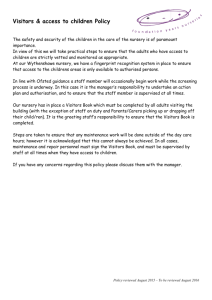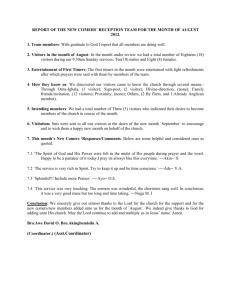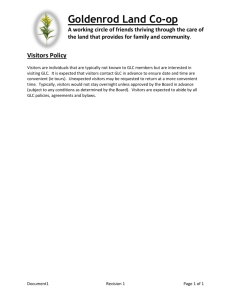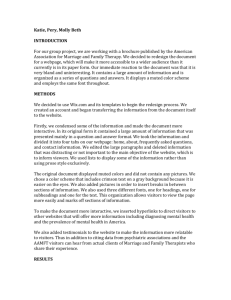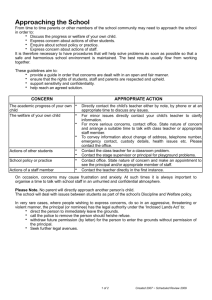Royal College of Surgeons in Ireland
advertisement
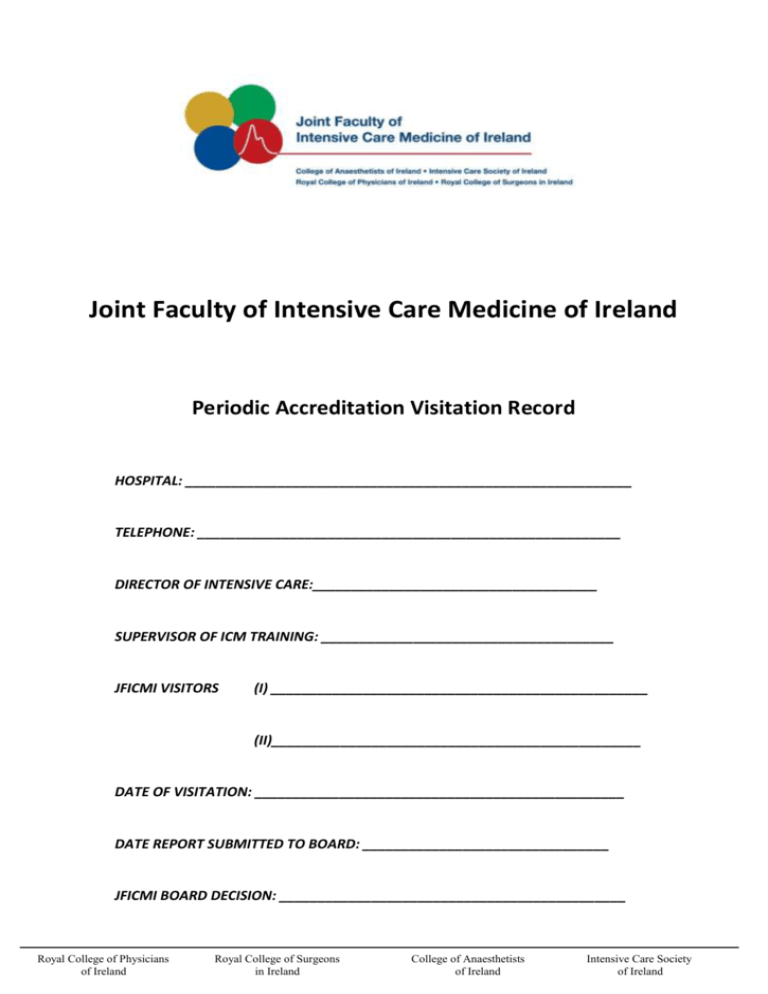
Joint Faculty of Intensive Care Medicine of Ireland Periodic Accreditation Visitation Record HOSPITAL: __________________________________________________________ TELEPHONE: _______________________________________________________ DIRECTOR OF INTENSIVE CARE:_____________________________________ SUPERVISOR OF ICM TRAINING: ______________________________________ JFICMI VISITORS (I) _________________________________________________ (II)________________________________________________ DATE OF VISITATION: ________________________________________________ DATE REPORT SUBMITTED TO BOARD: ________________________________ JFICMI BOARD DECISION: _____________________________________________ Royal College of Physicians of Ireland Royal College of Surgeons in Ireland College of Anaesthetists of Ireland Intensive Care Society of Ireland JFICMI Visitation Record Hospital Background Information (i) Hospital Data Hospital Hospital Group Beds (total) – Surgical Medical Paediatric Obstetric Inpatient Admissions / Discharges Outpatients A & E Attendances Theatre Case Load Obstetric Deliveries Case Mix Index (from HIPE data)Optional Other (ii) Hospital Staff Hospital Chief Executive / Secretary Manager Total Number of Staff (All) Total Number of Consultant Staff: JFICMI ACCREDITATION VISITATION RECORD THE RECORD CONSISTS OF FIVE SECTIONS: 1. The Questionnaire - including appendices 1 and 2 2. The Interview with Trainees, Trainers & Administration 3. The analysis of Compliance with EU training guidelines 4. The analysis of Compliance with: (a) JFICMI priority areas with (see section 4) (b) JFICMI National Standards THE HOSPITAL IS ASKED TO FILL IN THE DATA FOR SECTION 1 - THE QUESTIONNAIRE - BEFORE THE VISITATION. THIS ENTAILS ANSWERING THE FIRST PART OF EACH QUESTION. PLEASE LEAVE THE SECOND (SHADED) PART FREE FOR VISITORS’ COMMENTS. This document can either be completed by hand or as a word document on-screen and emailed to the JFICMI administrator. If completing on-screen, please do not alter the format of the questionnaire and ensure that information is entered in boxes provided. SECTION 1 THE QUESTIONNAIRE a) Structures f) Consultants b) Policies g) Trainee Doctors c) Nursing Appendix 1 d) Support Staffing Appendix 2 e) Support Facilities SECTION 1 QUESTIONNAIRE AND APPENDICES a) STRUCTURES (See also Appendix 1) 1. Is the ICU* a separate hospital area which caters for mechanical ventilation and invasively monitored cardiovascular intervention? Visitors’ comments 2. Is there a HDU#? If yes, how many beds therein? Visitors’ comments 3. Estimate the proportion of ICU beds occupied by ‘HDU Standard’ patients Visitors’ comments *DEFINITION The JFICMI definition / minimum standard for an ICU is: An Intensive Care Unit (ICU) must be a separate hospital area, equipped and staffed to be capable of mechanical ventilation and invasively monitored cardiovascular intervention for several days. It should have a designated consultant as medical director and be supported by suitably qualified other consultant or by an Intensive Care consultant group practice or rota. It is desirable that at least one of the consultant staff should carry Intensive Care Medicine accreditation. The director or the members of the consultant practice (or rota) should have intensive care consultant sessions (or equivalent) and must provide a critical care consultant service to the ICU and the hospital during normal working hours and provide a continuous on-call service. An ICU-based doctor must be present in the hospital and be available to the Unit on a 24-hour basis. The ICU must be able to provide a one-to-one nurse to patient ratio. The majority of its staff nurses should be Intensive Care accredited and a postgraduate teaching and accreditation programme is recommended. The Unit should have appropriate admission and discharge guidelines and there should be a continuing assessment of the appropriateness of intensive care from the time of patient referral to Intensive Care. Clinical Audit should be a component of the Intensive Care Medicine service and workload data should be available annually. An undergraduate medical teaching programme is desirable and participation in a post-graduate medical training programme is recommended. There should be an active Intensive Care research programme. #DEFINITION The JFICMI definition of a HDU is: An area offering a standard of care intermediate between the acute ward and full intensive care. The HDU should not manage patients with multiorgan failure, but should provide monitoring and support to patients at risk of developing organ system failure and/or provide low level single organ support. A HDU should be able to undertake short-term resuscitative measures and may provide ventilator support for a short time (usually less than 24 hours) prior to transfer of the patient to an ICU. Please feel free to append any supplementary or supportive documentation as appropriate. b) 1. (i) POLICIES Does the Unit have written admission/ discharge guidelines? Visitors’ comments 1. (ii) Do the guidelines recognise the role of the Intensive Care Consultant? Visitors’ comments 2. (i) (ii) Who is the Director/Medical Director Visitors’ comments 4. Are there regular administrative meetings? Visitors’ comments 5. Do the ICU medical staff have a responsibility for HDU patients? Visitors’ comments c) NURSING 1. Is there a senior nursing officer? Visitors’ comments 2. (i) 2. (ii) Does a one-to-one nurse:patient ratio pertain in the Unit? If not for all beds, please specify the number Visitors’ comments 3. Is there a nursing intensive care postgraduate certificate or diploma course? Visitors’ comments 4. If yes, do the medical staff (consultants and trainees) contribute to it? Visitors’ comments d) SUPPORT STAFFING 1. Does the Unit incorporate ward clerking staff? Visitors’ comments 2. Does the Unit incorporate secretarial staff? Visitors’ comments 3. Does the Unit incorporate receptionist staff? Visitors’ comments 4. Does the Unit incorporate biomedical technical staff? Visitors’ comments 5. Is there a Unit based physiotherapy service? Visitors’ comments 6. Is there an infection control nurse / service Visitors’ comments 7. Is there a Unit based pharmacy service? Visitors’ comments 8. Is there dietetics/dieticians support? Visitors’ comments e) SUPPORT FACILITIES 1. Is there a stat laboratory, e.g. ABGs Lactate Glucose K Ca Mg Hb Oximetry Na Visitors’ comments 2. Please tick measurement available Please add other POC facilities and identify QA process Other Is there an ICU facility for distressed relatives and patient interview Visitors’ comments 3. Does the Unit have access to does the unit have immediate access to the following diagnostics 24 hour CT / MRI Mobile ultrasound diagnostic service Ready availability of renal replacement therapy Echocardiography – e.g. Transoesophageal OTHER Please tick those available (for Other, please give details below) Visitors’ comments f) CONSULTANTS 1. How many consultants have intensive care sessions (or other recognised time allocation)? Visitors’ comments 2. Is there an intensive care consultant group practice or specific Intensive Care rota? Visitors’ comments 3. How many routine clinical hours of consultant time are allocated and dedicated to critical care per week Visitors’ comments 5. Is there at least one reference intensive care consultant who carries two years of intensive care medicine training? (criterion for ‘Intensivist’ used by Rep of Ireland and Northern Ireland authorities and by the European Society of Intensive Care medicine.) Visitors’ comments 6. How many of the I.C. consultants hold specialist intensive care accreditation? Please specify Visitors’ comments 7. Does the Unit maintain a clinical audit? (See also Appendix 1) Please enclose recent audit cycle report Visitors’ comments 8. How often are audit meetings held? Visitors’ comments g) TRAINEE DOCTORS 1. Do doctors-in-training in the ICU also have non-intensive care duties? (If yes, please specify) Visitors’ comments 2. What is the normal ratio of trainee doctor to ICU beds? Visitors’ comments 3. Is there always a minimum of one doctor (usually a trainee) immediately available to ICU patients? Visitors’ comments 4. How many I.C. trainees are assigned to Intensive Care? Weekday Week night Visitors’ comments Weekend 5. Describe what modules of training are available in this critical care practice: Modules of 2 moinths; modules of 3 months; modules of 6 months. Are the modules of training in ICM available across a range of specialties – anaesthesia, surgery, medicine, A&E, other Visitors’ comments h) QUALITY OF TRAINING 1. Are there regular (twice daily) ward rounds/medical handovers? Visitors’ comments 2. Are there regular (i.e. a minimum of one per day) consultant medical teaching rounds? Visitors’ comments 3. Are there microbiology review sessions? Visitors’ comments 4. Are there radiology review sessions? Visitors’ comments 5. Is there a regular clinical Education / audit meeting? (minimum of once per week) Visitors’ comments 6. Are the clinical meetings multi-disciplinary in nature? Visitors’ comments 7. Is the Unit involved in clinical or other research? Visitors’ comments 8. Are trainees encouraged to be actively involved in all of the above? Visitors’ comments 9. Have trainees the opportunity to attend other relevant teaching / clinical sessions? Visitors’ comments APPENDIX 1 (Question 10 is optional) 1. How many beds in your hospital? 2. If there are a number of hospitals in formal liaison, how many hospital beds are serviced by ICU? 3. a)How many ICU beds are there? b )How many HDU beds within remit of critical care service 4. How many Isolation beds are there? - In ICU - In HDU 5. How many patients are admitted per year 6. What is the bed occupancy as a percentage of bed days 7. a)What is the mean duration of ICU stay? b)What is the median ICU length of stay c)What is mean HDU length of stay d)What is median HDU length of stay 8. What proportion of patients are ventilated? 9. What proportion of ICU patient days are ‘ventilator days’? - ICU - HDU 10. (OPTIONAL) What number / proportion of patients are (a) elective no. % of admissions non-elective no. % of admissions following surgery no. % of admissions from A&E no. % of admissions from wards no. % of admissions readmission no. % of admissions from other hospitals no. % of admissions direct referrals from other ICUs/HDUs no. % of admissions referred primarily for Intensive Care Medicine no. % of admissions referred primarily to other national or regional specialties at your hospital no. % of admissions (b) Visitors’ comments APPENDIX 2 (All questions optional) (a) How many patients have invasive cardiac output monitoring per annum? (b) What % of patients have high nursing dependency – e.g. ventilator + > 3 infusions? Infection at admission: no. % of admissions CPR on day of admission no. % of admissions Active cancer at admission no. % of admissions How many patients undergo CVVHD per year? (c) (d) (e) (f) (g) (h) What proportion of ICU patients days are ‘CVVHD days’? the mean and median admission APACHE score (i) the mean and median patient age (j) number of deaths the unit mortality (l) (m) number in whom withdrawal of interventions is a factor number of brain dead patients (n) number of organ donor patients (o) the hospital mortality (p) if known, your standardised mortality ratio (q) How many patients require isolation for HCAI or other transmissible infections per annum? (r) Percutaneous Tracheostomies no. performed on ICU patients How many operative tracheostomies are performed on ICU patients number of acute renal failure patients (s) creatinine rise of > 150 mcmol/L above baseline dialysis/CVVHD dependant (t) What is the casemix breakdown in your ICU? Attach separate local report if available % of admissions Visitors’ comments COMMENTS ON STRUCTURE OF QUESTIONNAIRE AND SUGGESTIONS FOR IMPROVEMENT BY VISITORS OR HOSPITAL STAFF End of questionnaire SECTION 2 INTERVIEWS WITH TRAINERS, TRAINEES & ADMINISTRATION 1. TRAINERS (Consultants involved in training / working in ICM) Consultants met on visitation Notes and comments 2. TRAINEES Visitors met: Positive Comments: Negative comments: 3. Administration SECTION 3 COMPLIANCE WITH ACMT CRITERIA?: (ACMT: Advisory Committee on Medical Training –EU) a) Training Program b) Tutor and model(s) of good practice c) Opportunity for theoretical Training d) Trainee Professional Development & Trainer / Trainee Feedback e) Continuous Assessment f) Training System Support Facilities (Clinical and Academic) SECTION 4 - COMPLIANCE WITH JFICMI PRIORITY AREAS Clinical Governance Standard All Critical Care Units should have a Medical Director (Director of Critical Care Medicine), with clearly defined administrative time to perform that function The Medical Director will lead critical care services across the hospital, including steering critical care policy, strategy and operational activities and audit. The role of the Medical Director of Critical Care Medicine should be recognized by the hospital Clinical Director and be clearly identified within the hospital directorate or equivalent structure. The Medical Director of the Critical Care Unit should either be a Fellow of the Joint Faculty of Intensive Care Medicine of Ireland or hold an equivalent qualification Quality of patient care and outcomes require support from a clinical audit and benchmarking process. It is the responsibility of the hospital and the healthcare region which the Critical Care Unit serves to invest in the appropriate hardware, software, and staffing to support clinical audit. The Units need to have clinical incident reporting, identified key performance indicators and a mechanism for analysis, feedback and operational change. The Medical Director of the Compliant Comment Unit(s) shall work in close collaboration with an appointed senior Clinical Nurse Manager, Assistant Director of Nursing, or equivalent dedicated to the Unit(s) Nursing management should consist of a Clinical Nurse Manager who runs the Unit for each shift and does not have direct individual patient clinical responsibilities during that shift; reporting to a Clinical Nurse Lead with overall responsibility for nursing in the Unit. The Clinical Nurse lead will, in turn report to the Divisional Nurse Manager or otherwise as relevant to local hospital structures. The Clinical Nurse lead has a defined management role and function, leads the nursing team in the Unit, supervises their education and training and in conjunction with the Medical Director and the multidisciplinary team, shapes the clinical direction of the Unit The design of an Intensive Care Unit for any hospital must address Standard Infrastructure and building standards Compliant Comment Accessibility – the right number of beds for case-mix and referral base Patient focus Ergonomic working environment Infection Control standards Patient Dignity Family and next-of-kin Hub accessibility within the hospital to and from all interdependent services Integration within hospital systems – e.g. Information Technology etc Medical Staffing Standard 24 hour availability of a dedicated Consultant in Critical Care Medicine who has exclusive sessional commitment to Intensive Care Medicine (ICM) and no conflicting clinical commitment for that period. New appointments should fulfill the accreditation criteria of Consultant with an Interest in Intensive Care Medicine or Consultant in Intensive Care Medicine. It is desirable to provide for blocks of Critical Care Unit time for each consultant of at least 3-4 days at a time rather than changing on a daily basis. Compliant Comment one non-consultant hospital doctor (NCHD) for each six to eight critical care patients, depending on local case-mix The ratio of NCHD to patients out of hours will be determined by local case mix and activity, but should not exceed one NCHD to every twelve patients. Critical Care registrar(s) should not have any concurrent responsibilities and on-call accommodation should be provided in, or appropriately close to the Unit The consultant to patient ratio should be a minimum one consultant to twelve critical care patients during routine hours. This may increase to a minimum of one consultant to thirty critical care patients out-ofhours, depending on case mix and where supported by appropriate trainee and NCHD staffing. SECTION 5 – VISITORS GENERAL SUMMARY Positive aspects: Negative aspects: Summary and conclusion: Signed: _____________________ ____________________


